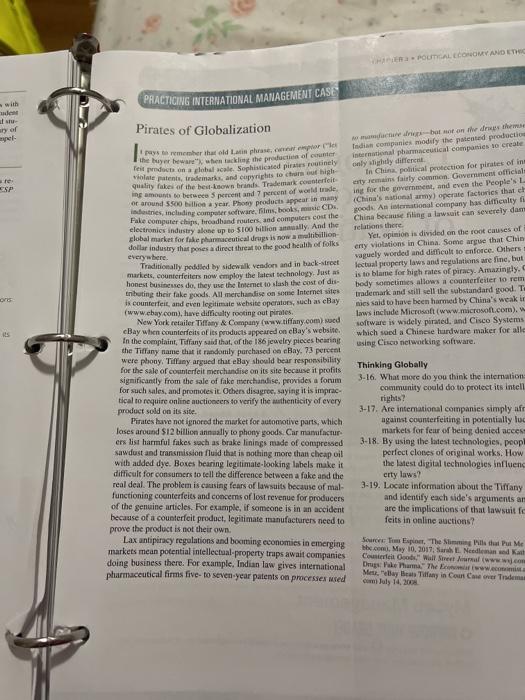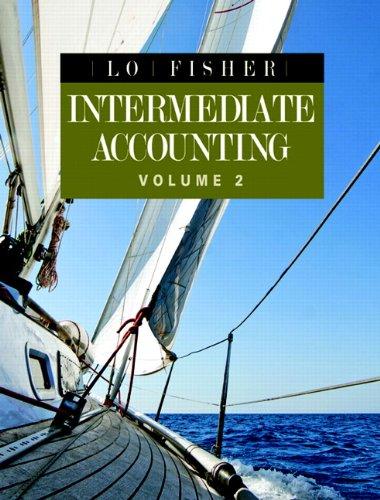HER POUTAL ECONOMY ANDET PRACTICING INTERNATIONAL MANAGEMENT CASE re bator on the drives the Indian companies modify the patented production International pharmaceutical companies to create only slightly different In China political protection for pirates of in tymais fairly common Government official ing for the government, and even the People's China's national army) operate factories that poodi An international company has difficultyfi China because filing a lawsuit can severely dam relations there Yet, opinion is divided on the root causes of erty violations in China. Some argue that Chin vaguely worded and difficult to enforce. Others lectual property laws and regulations are fine, but is to blame for high rates of piracy. Amazingly. body sometimes allows a counterfeiter to rem trademark and still sell the substandard good. T. nies said to have been harmed by China's weak in lows include Microsoft (www.microsoft.com), software is widely pirated, and Cisco Systems which seed a Chinese hardware maker for alle using Cisco networking software. its Pirates of Globalization to remember that old Latin plus, compare the buyer beware when taking the production of counter Telt pidato anche sophisticated pirates routinely Wiolate patents, trademarks and copyrights to churuf high quality fakes of the best-known brand Trademark counterfeit amount to betwee percent and 7 percent of world trade or around 500 billion a year. Phony products appear in many denies, including computer software, films, books, mie CD Fale computer chips, broadband routers, and computers cout the electronics industry alone up to $100 billion annually. And the slobal market for fake pharmaceutical drugs is now a multibillion dollar industry that penes a direct threat to the good health of folks everywhere Traditionally peddled by sidewalk vendon and in backstreet markets, counterfeiters now employ the latest technology. Just as honest businesses do they use the Internet to slash the cost of dis- tnbuting their fake goods. All merchandise on some Internet sites is counterfeit, and even legitimate website operators, such as eBay www.ebay.com), huve difficulty rooting out pirates New York retailer Tiffany & Company (www.tiffany.com) sued cBay when counterfeits of its products appeared on eBay's website In the complaint, Tiffany said that of the 186 jewelry pieces bearing the Tiffany name that it randomly parchased on eBay, 73 percent were phony, Tiffany argued that eBay should bear responsibility for the sale of counterfeit merchandise on its site because it profils significantly from the sale of fake merchandise, provides a forum for such sales, and promotes it. Others disagree, saying it is imprac tical to require online auctioneers to verify the authenticity of every product sold on its site. Pirates have not ignored the muket for automotive parts, which loses around $12 billion annually to phony goods. Car manufactur ers list harmful fakes such as brake linings made of compressed sawdust and transmission fluid that is nothing more than cheap oil with added dye. Boxes bearing legitimate-looking labels make it difficult for consumers to tell the difference between a fake and the real deal. The problem is causing fears of lawsuits because of mal- functioning counterfeits and concems of lost revenue for producers of the genuine articles. For example, if someone is in an accident because of a counterfeit product, legitimate manufacturers need to prove the product is not their own. Lax antipiracy regulations and booming economies in emerging markets mean potential intellectual property traps await companies doing business there. For example, Indian law gives international pharmaceutical firms five-to seven-year patents on processes used Thinking Globally 3-16. What more do you think the internation community could do to protect its intell rights? 3-17. Are interational companies simply af against counterfeiting in potentially luc markets for fear of being denied acces 3-18. By using the latest technologies, peop perfect clones of original works. How the latest digital technologies influenc crty laws? 3-19. Locate information about the Tiffany and identify each side's arguments ar are the implications of that lawsuit fe feits in online auctions? Source Exploe, The Sims that Put Me the.com May 10, 2017 SL Needlem sedan Custom Wall Street (www.com Drugs: Pake Thurma. The www. Meu, eBay ban Tifanyin Cou Cower Trade com y 14, 2008 HER POUTAL ECONOMY ANDET PRACTICING INTERNATIONAL MANAGEMENT CASE re bator on the drives the Indian companies modify the patented production International pharmaceutical companies to create only slightly different In China political protection for pirates of in tymais fairly common Government official ing for the government, and even the People's China's national army) operate factories that poodi An international company has difficultyfi China because filing a lawsuit can severely dam relations there Yet, opinion is divided on the root causes of erty violations in China. Some argue that Chin vaguely worded and difficult to enforce. Others lectual property laws and regulations are fine, but is to blame for high rates of piracy. Amazingly. body sometimes allows a counterfeiter to rem trademark and still sell the substandard good. T. nies said to have been harmed by China's weak in lows include Microsoft (www.microsoft.com), software is widely pirated, and Cisco Systems which seed a Chinese hardware maker for alle using Cisco networking software. its Pirates of Globalization to remember that old Latin plus, compare the buyer beware when taking the production of counter Telt pidato anche sophisticated pirates routinely Wiolate patents, trademarks and copyrights to churuf high quality fakes of the best-known brand Trademark counterfeit amount to betwee percent and 7 percent of world trade or around 500 billion a year. Phony products appear in many denies, including computer software, films, books, mie CD Fale computer chips, broadband routers, and computers cout the electronics industry alone up to $100 billion annually. And the slobal market for fake pharmaceutical drugs is now a multibillion dollar industry that penes a direct threat to the good health of folks everywhere Traditionally peddled by sidewalk vendon and in backstreet markets, counterfeiters now employ the latest technology. Just as honest businesses do they use the Internet to slash the cost of dis- tnbuting their fake goods. All merchandise on some Internet sites is counterfeit, and even legitimate website operators, such as eBay www.ebay.com), huve difficulty rooting out pirates New York retailer Tiffany & Company (www.tiffany.com) sued cBay when counterfeits of its products appeared on eBay's website In the complaint, Tiffany said that of the 186 jewelry pieces bearing the Tiffany name that it randomly parchased on eBay, 73 percent were phony, Tiffany argued that eBay should bear responsibility for the sale of counterfeit merchandise on its site because it profils significantly from the sale of fake merchandise, provides a forum for such sales, and promotes it. Others disagree, saying it is imprac tical to require online auctioneers to verify the authenticity of every product sold on its site. Pirates have not ignored the muket for automotive parts, which loses around $12 billion annually to phony goods. Car manufactur ers list harmful fakes such as brake linings made of compressed sawdust and transmission fluid that is nothing more than cheap oil with added dye. Boxes bearing legitimate-looking labels make it difficult for consumers to tell the difference between a fake and the real deal. The problem is causing fears of lawsuits because of mal- functioning counterfeits and concems of lost revenue for producers of the genuine articles. For example, if someone is in an accident because of a counterfeit product, legitimate manufacturers need to prove the product is not their own. Lax antipiracy regulations and booming economies in emerging markets mean potential intellectual property traps await companies doing business there. For example, Indian law gives international pharmaceutical firms five-to seven-year patents on processes used Thinking Globally 3-16. What more do you think the internation community could do to protect its intell rights? 3-17. Are interational companies simply af against counterfeiting in potentially luc markets for fear of being denied acces 3-18. By using the latest technologies, peop perfect clones of original works. How the latest digital technologies influenc crty laws? 3-19. Locate information about the Tiffany and identify each side's arguments ar are the implications of that lawsuit fe feits in online auctions? Source Exploe, The Sims that Put Me the.com May 10, 2017 SL Needlem sedan Custom Wall Street (www.com Drugs: Pake Thurma. The www. Meu, eBay ban Tifanyin Cou Cower Trade com y 14, 2008







